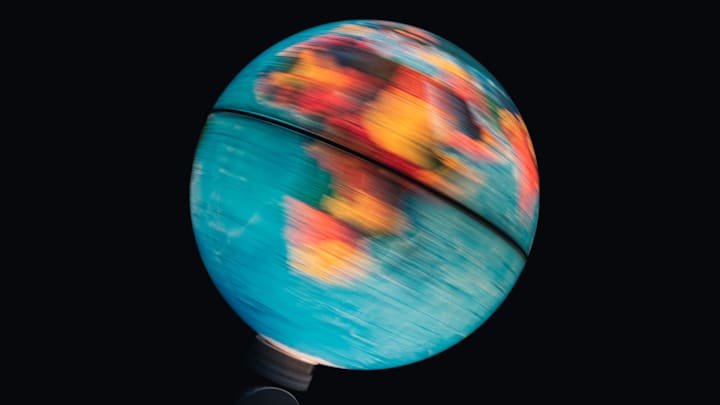Over many years of science classes, the message that Earth rotates on its axis probably lodged itself firmly in your brain and has stayed there since. But did your teachers happen to mention in which direction Earth spins—and, if so, do you remember it?
Actually, there isn’t just one correct response: It depends on your position in relation to Earth itself. If you’re imagining yourself floating above the planet and looking down at the North Pole directly below you, Earth would appear to be rotating counterclockwise. If you’re below Earth, looking at the South Pole above you, you’d describe the rotation as clockwise.
The rotational direction helps shed light on why the sun “rises” in the east and “sets” in the west—because Earth is turning from west to east. Imagine yourself observing Earth from the sun’s perspective just before the day begins in North America. As Earth rotates eastward, sunlight hits the East Coast first; so when New Yorkers are starting their day, Californians are still sleeping in total darkness. As Earth continues its easterly rotation, the sun shines on more and more of North America. In other words, we humans on the ground are moving into sunlight that’s already shining on land east of us—so we can see the sunlight approaching if we look to the east.

The same thing happens at sunset. Earth keeps spinning east, and eventually the East Coast rotates right out of the sun’s purview and into darkness. The sun is still shining on land west of that, so East Coasters can watch their own daylight recede by looking westward.
Why Does the Earth Rotate Counterclockwise?
The reason Earth rotates counterclockwise (i.e. west to east) is less clear. Our solar system was created when a cloud of dust and gas collapsed—possibly because another star exploded near it—and the matter, thanks in part to gravity, reoriented itself into a star and a set of planets (plus moons, asteroids, and so forth). An offshoot of new star formation is that the star and other things around it rotate, but the direction depends on variables at play during the cloud collapse.
“Factors such as turbulence caused by supernova shock waves and magnetic effects that occur when portions of the cloud start collapsing into stars affect the final angular momentum and spin orientation of newborn stars,” Astronomy’s Alison Klesman explained.
For our solar system, that spin orientation ended up being counterclockwise, or “prograde.” The Earth, the sun, and most of the other planets all rotate in that direction. Venus, however, spins clockwise; and Uranus rotates on its side. Some scientists believe they used to match our spin orientation before an event occurred that knocked them out of whack—like one massive collision or a series of smaller ones. But we’re far from certain about what really happened.
